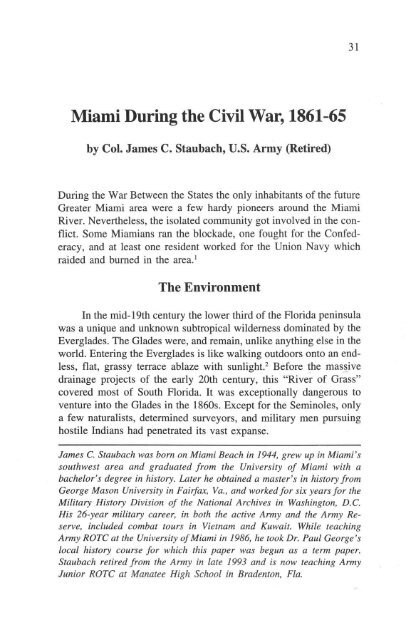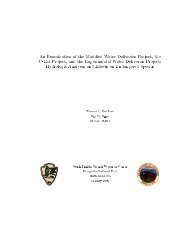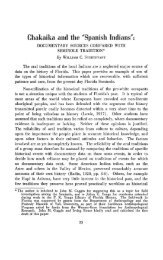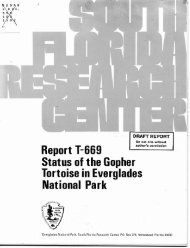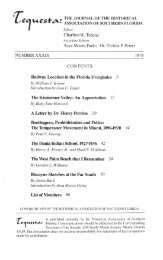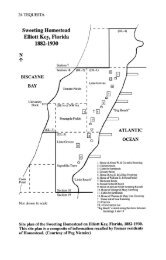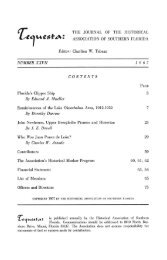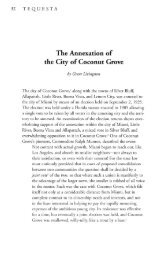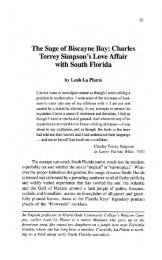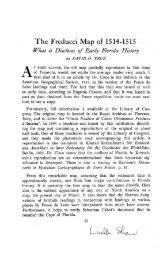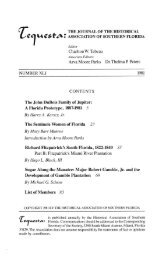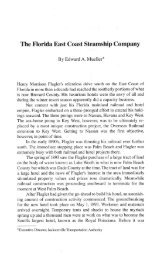Miami During the Civil War - FIU Digital Collections
Miami During the Civil War - FIU Digital Collections
Miami During the Civil War - FIU Digital Collections
Create successful ePaper yourself
Turn your PDF publications into a flip-book with our unique Google optimized e-Paper software.
31<br />
<strong>Miami</strong> <strong>During</strong> <strong>the</strong> <strong>Civil</strong> <strong>War</strong>, 1861-65<br />
by Col. James C. Staubach, U.S. Army (Retired)<br />
<strong>During</strong> <strong>the</strong> <strong>War</strong> Between <strong>the</strong> States <strong>the</strong> only inhabitants of <strong>the</strong> future<br />
Greater <strong>Miami</strong> area were a few hardy pioneers around <strong>the</strong> <strong>Miami</strong><br />
River. Never<strong>the</strong>less, <strong>the</strong> isolated community got involved in <strong>the</strong> conflict.<br />
Some <strong>Miami</strong>ans ran <strong>the</strong> blockade, one fought for <strong>the</strong> Confederacy,<br />
and at least one resident worked for <strong>the</strong> Union Navy which<br />
raided and burned in <strong>the</strong> area.'<br />
The Environment<br />
In <strong>the</strong> mid-19th century <strong>the</strong> lower third of <strong>the</strong> Florida peninsula<br />
was a unique and unknown subtropical wilderness dominated by <strong>the</strong><br />
Everglades. The Glades were, and remain, unlike anything else in <strong>the</strong><br />
world. Entering <strong>the</strong> Everglades is like walking outdoors onto an endless,<br />
flat, grassy terrace ablaze with sunlight. 2 Before <strong>the</strong> massive<br />
drainage projects of <strong>the</strong> early 20th century, this "River of Grass"<br />
covered most of South Florida. It was exceptionally dangerous to<br />
venture into <strong>the</strong> Glades in <strong>the</strong> 1860s. Except for <strong>the</strong> Seminoles, only<br />
a few naturalists, determined surveyors, and military men pursuing<br />
hostile Indians had penetrated its vast expanse.<br />
James C. Staubach was born on <strong>Miami</strong> Beach in 1944, grew up in <strong>Miami</strong>'s<br />
southwest area and graduated from <strong>the</strong> University of <strong>Miami</strong> with a<br />
bachelor's degree in history. Later he obtained a master's in history from<br />
George Mason University in Fairfax, Va., and worked for six years for <strong>the</strong><br />
Military History Division of <strong>the</strong> National Archives in Washington, D.C.<br />
His 26-year military career, in both <strong>the</strong> active Army and <strong>the</strong> Army Reserve,<br />
included combat tours in Vietnam and Kuwait. While teaching<br />
Army ROTC at <strong>the</strong> University of <strong>Miami</strong> in 1986, he took Dr. Paul George's<br />
local history course for which this paper was begun as a term paper.<br />
Staubach retired from <strong>the</strong> Army in late 1993 and is now teaching Army<br />
Junior ROTC at Manatee High School in Bradenton, Fla.
32 TEQUESTA<br />
Dry land along <strong>the</strong> lower sou<strong>the</strong>ast coast consisted of a narrow<br />
coastal ridge, six and one-half miles wide, wedged between <strong>the</strong> Everglades<br />
and <strong>the</strong> Atlantic Ocean. Stretching west to east across this<br />
ridge from <strong>the</strong> Glades to <strong>the</strong> Atlantic was a river known as <strong>the</strong> <strong>Miami</strong><br />
River. The source of this clear freshwater river was in <strong>the</strong> Glades and<br />
it emptied into <strong>the</strong> Atlantic at Biscayne Bay. The nucleus of <strong>the</strong><br />
pioneer community of <strong>Miami</strong> was here where <strong>the</strong> river met <strong>the</strong> bay,<br />
its isolation making it a virtual island.<br />
Despite <strong>the</strong> presence of freshwater, <strong>the</strong> land was unsuited for<br />
conventional agriculture. Shallow soil covered a dense shelf of oolitic<br />
limestone and <strong>the</strong> highest spots were covered by pine woodlands and<br />
palmetto shrubs with mangrove hammocks close to <strong>the</strong> shore. Huge<br />
swarms of mosquitoes, from which smoke pots and nets offered only<br />
partial relief, infested <strong>the</strong> area. Overall it was a harsh and challenging<br />
environment.<br />
Lack of transportation compounded <strong>the</strong> geographic isolation of<br />
early <strong>Miami</strong>. No railroads, roads or trails connected South Florida<br />
with <strong>the</strong> remainder of <strong>the</strong> state. Most travelers arrived by boat from<br />
Key West, <strong>Miami</strong>'s outlet to <strong>the</strong> world. About 140 nautical miles<br />
from <strong>Miami</strong>, Key West was a fair sized port city in 1860 and <strong>the</strong><br />
second largest town in Florida. It was culturally a sou<strong>the</strong>rn city with<br />
a population of 2,862 people, including 451 slaves and 160 free<br />
blacks. 3 Before <strong>the</strong> war a schooner, <strong>the</strong> Joshua Skinner, made one<br />
round-trip a month from Key West. The vessel left Key West on <strong>the</strong><br />
eighth of <strong>the</strong> month and sailed from <strong>Miami</strong> on <strong>the</strong> 25th. It carried<br />
mail, freight, and an infrequent passenger. 4<br />
The only way to get to <strong>Miami</strong> by land was to walk <strong>the</strong> beach<br />
along <strong>the</strong> wild and unsettled east coast. The only inhabitants between<br />
<strong>Miami</strong> and Jupiter Lighthouse, about 80 miles north, lived at Fort<br />
Lauderdale. 5 Travelers from <strong>Miami</strong> had to walk <strong>the</strong> beach for ano<strong>the</strong>r<br />
25 miles north of <strong>the</strong> Jupiter Lighthouse to reach a small cluster of<br />
homes at St. Lucie Inlet on Indian River. The closest community was<br />
ano<strong>the</strong>r 35 miles north. 6 It took "barefoot mailmen" three days to<br />
cover <strong>the</strong> route between <strong>Miami</strong> and Jupiter. Among <strong>the</strong> most unique<br />
mail carriers in American history, <strong>the</strong>se intrepid pioneers went barefoot<br />
to keep <strong>the</strong>ir shoes dry while walking on <strong>the</strong> hardest part of <strong>the</strong><br />
beach where <strong>the</strong> water washed and <strong>the</strong> footing was best. They carried<br />
mail from St. Augustine 315 miles to <strong>Miami</strong> and back. A blazing sun<br />
as well as pan<strong>the</strong>rs, alligators, bears, and sharks in <strong>the</strong> inlets made<br />
this a dangerous and sometimes fatal trek. 7 Because of its inaccessibility,<br />
few people visited <strong>Miami</strong>, and <strong>the</strong> loneliness was oppressive. 8
<strong>Miami</strong> <strong>During</strong> <strong>the</strong> <strong>Civil</strong> <strong>War</strong> 33<br />
The Indians<br />
Indian troubles during <strong>the</strong> 1830s, 1840s, and 1850s helped keep<br />
<strong>the</strong> visitors away. A symbol of <strong>Miami</strong>'s vulnerability to hostile Seminoles<br />
was also <strong>the</strong> dominant structure in <strong>the</strong> area: <strong>the</strong> Cape Florida<br />
Lighthouse at <strong>the</strong> tip of Key Biscayne. In a well-publicized incident<br />
in 1836, <strong>the</strong> Indians attacked this white, 95 foot brick tower killing<br />
<strong>the</strong> assistant and leaving <strong>the</strong> keeper for dead. Twenty years later, in<br />
1856, <strong>the</strong> Seminoles ambushed and killed two settlers in what is now<br />
Coconut Grove. The whites were not entirely innocent, having sold<br />
adulterated gunpowder to <strong>the</strong> Indians. These shocking events discouraged<br />
many settlers and dashed <strong>the</strong> hopes of those who had plans to<br />
establish a major settlement on <strong>the</strong> site. 9<br />
When <strong>the</strong> danger was greatest, <strong>the</strong> settlers found refuge with <strong>the</strong><br />
U.S. Army at Fort Dallas located at <strong>the</strong> mouth of <strong>the</strong> <strong>Miami</strong> River.<br />
The Army used <strong>the</strong> fort during <strong>the</strong> last two Indian wars as a base of<br />
operations against <strong>the</strong> Seminoles. <strong>During</strong> <strong>the</strong> final period of occupation,<br />
1855-58, known as <strong>the</strong> Third Seminole <strong>War</strong>, <strong>the</strong> soldiers made<br />
many improvements to <strong>the</strong> area. Lieutenant Abner Doubleday, later<br />
falsely known as <strong>the</strong> inventor of baseball, led construction of a 16-<br />
foot wide road from <strong>Miami</strong> to Fort Lauderdale. The Army reconstructed<br />
two stone buildings originally built by William English. English<br />
had a plantation on <strong>the</strong> <strong>Miami</strong> River and planned to build <strong>the</strong> "Village<br />
of <strong>Miami</strong>." The Army incorporated <strong>the</strong>se stone buildings into<br />
Fort Dallas. They were both two story and measured 95 by 17 feet<br />
A view of Fort Dallas, published March 1871 in Harper's New Monthly<br />
Magazine in J.B. Holder's article, "Along <strong>the</strong> Florida Reef." (Historical<br />
Association of Sou<strong>the</strong>rn Florida, 75-50-1)
34 TEQUESTA<br />
and 42 by 20 feet. Using local wood and imported lumber, <strong>the</strong> soldiers<br />
added five new officers' quarters, a hospital, guardhouse, magazine,<br />
stables, and o<strong>the</strong>r smaller buildings. <strong>During</strong> this period <strong>the</strong><br />
complex consisted of approximately 13 buildings with no walls. 10 It<br />
greatly impressed a visitor in March of 1858 who wrote, it was "a<br />
beautiful sight; <strong>the</strong> stars and stripes floating from a tall flagstaff<br />
erected on <strong>the</strong> parade ground, all clean and covered with Bermuda<br />
grass . . . planted with flowers, shrubbery and vegetables of all<br />
kinds." 1<br />
The Army left Fort Dallas in <strong>the</strong> hands of caretakers and <strong>the</strong><br />
locals put <strong>the</strong> buildings to good use as a residence, trading post, and<br />
temporary quarters for newly arrived settlers. It remained <strong>the</strong> center<br />
of <strong>the</strong> pioneer community throughout most of <strong>the</strong> second half <strong>the</strong> 19th<br />
century. 12 After <strong>the</strong> third and final Seminole Indian <strong>War</strong> ended in<br />
1858, a small number of undefeated Seminoles slipped deeper into <strong>the</strong><br />
vastness of <strong>the</strong> Everglades, but <strong>the</strong> continual warfare had damaged<br />
<strong>Miami</strong>'s reputation.<br />
The Pioneers<br />
The pioneers who stayed to make a home in this wilderness<br />
depended on <strong>the</strong> ocean as a link to <strong>the</strong> world and as a source of<br />
income. A busy sea lane was directly offshore and parallel to <strong>the</strong><br />
coast. <strong>During</strong> <strong>the</strong> first half <strong>the</strong> 19th century, one of <strong>the</strong> leading activities<br />
was "wrecking," or <strong>the</strong> legal and illegal salvaging of ships<br />
stranded or destroyed on <strong>the</strong> treacherous Florida Reef. In <strong>the</strong> 1850<br />
and 1860 Censuses some reported <strong>the</strong>ir occupation as "mariner," a<br />
euphemism for wrecker. By 1861 improved maps, steam powered<br />
ships, and <strong>the</strong> Cape Florida Lighthouse reduced <strong>the</strong> number of wrecks<br />
along <strong>the</strong> coast.<br />
Right: The sketchmap of <strong>Miami</strong>, circa April 1861, was created with<br />
information from a number of sources: Richards, "Reminiscences;"<br />
Sketch, Headquarters Map File L-89-24,1855-1857, Records of <strong>the</strong> Office<br />
of <strong>the</strong> Chief of Engineers, Record Group 77, Cartographics Division,<br />
National Archives, Washington, D.C.; Lieutenant Robinson's map, in<br />
Parks, <strong>Miami</strong> The Magic City, p. 35; maps drawn by Surveyor F. H.<br />
Gerdes, 1849, "<strong>Miami</strong>: The Way We Were, The <strong>Miami</strong> News, February<br />
16, 1985, p. 4C; and in addition, many sources cited in footnotes contain<br />
information about locations of natural features and structures.
<strong>Miami</strong> <strong>During</strong> <strong>the</strong> <strong>Civil</strong> <strong>War</strong> 35<br />
E<br />
Barmhart I<br />
V<br />
Sear's Home Storne<br />
S \•...Io,' fan crar IrT 1<br />
T ~ \C Jones Mif f<br />
Se<br />
& W6 ftcher Mif<br />
MDangrove<br />
d<br />
I Marsha Is. \Home W.<br />
fo mer \<br />
W oo' s &- Mi miff .<br />
Adfi)ams<br />
Sissle<br />
Lewis'<br />
Nomie, Mif<br />
Littfe Y verf<br />
S HomeVn Homr ) ,"<br />
]<br />
buaO<br />
N Oar?<br />
p<br />
D ^ afas ^Miam v<br />
'Y<br />
e r<br />
b Il u / ,<br />
B arwrow -Doc ' ' -<br />
Puunct BoBc-<br />
I<br />
Bighthouse<br />
Addis / ~on<br />
Hamm/ ockF<br />
.I<br />
S o' owey Apcd.
36 TEQUESTA<br />
The production of starch from <strong>the</strong> native comptie plant became<br />
more important to <strong>the</strong> economy, and on <strong>the</strong> eve of <strong>the</strong> <strong>Civil</strong> <strong>War</strong> it<br />
was <strong>the</strong> leading occupation. The comptie plant, which grows wild in<br />
<strong>the</strong> pinelands, is a small cycad with foot-long green fronds like a<br />
miniature palm. Comptie starch, produced by <strong>the</strong> grinding of <strong>the</strong> root<br />
into a white powder, could be used for laundry or as a flour substitute.<br />
To grind <strong>the</strong> roots <strong>the</strong> settlers used large mills with water wheels<br />
powered by <strong>the</strong> <strong>Miami</strong> River, as well as horses and small, handoperated<br />
machines. They consumed <strong>the</strong> starch and sold it at Key West<br />
for $12 a barrel. Arrowroot Starch was <strong>the</strong> product's commercial name.<br />
Along with wrecking and making starch, <strong>the</strong> settlers tended <strong>the</strong>ir<br />
gardens, grew fruit trees, and lived off <strong>the</strong> local fish and game. Most<br />
settlers engaged in all <strong>the</strong>se activities. 13<br />
This harsh and isolated environment discouraged settlement, and<br />
at <strong>the</strong> start of <strong>the</strong> <strong>Civil</strong> <strong>War</strong> <strong>the</strong>re were probably fewer than 150<br />
settlers in <strong>the</strong> entire sou<strong>the</strong>ast portion of <strong>the</strong> state, an area of 6,000<br />
square miles. In <strong>the</strong> future Greater <strong>Miami</strong> area, <strong>the</strong> 1860 Census<br />
reported only 28 settlers, but 40 is a more realistic estimate. These<br />
pioneers, like most modern <strong>Miami</strong> area residents, were immigrants<br />
from ano<strong>the</strong>r area, state, or country. Of <strong>the</strong> 28 settlers listed in <strong>the</strong><br />
1860 Census, 14 were foreign born and some were former soldiers or<br />
civilian employees of <strong>the</strong> Army.14<br />
We know a great deal about William Wagner and his family<br />
because in 1903 his daughter Rose provided an invaluable chronicle<br />
of <strong>the</strong> war years in a series of articles for The <strong>Miami</strong> News. She was<br />
nine years old when <strong>the</strong> <strong>Civil</strong> <strong>War</strong> began and recorded her reminiscences<br />
38 years after <strong>the</strong> war. Although much of her account must<br />
be attributed to what she learned from o<strong>the</strong>rs during her long life in<br />
<strong>Miami</strong>, her story is vivid and informative. Her fa<strong>the</strong>r, William Wagner,<br />
had been wounded in <strong>the</strong> Mexican <strong>War</strong> and brought his family to<br />
<strong>Miami</strong> between 1855 and 1857. He was a sutler with <strong>the</strong> U.S. Army<br />
during <strong>the</strong> last military occupation of Fort Dallas and later probably<br />
worked for a Capt. Sinclair operating a comptie mill on a tributary<br />
of <strong>the</strong> <strong>Miami</strong> River. Steam powered this large mill. Sinclair also<br />
owned two schooners that made trips between <strong>Miami</strong> and Key West.<br />
Wagner's homestead was on <strong>the</strong> same tributary as <strong>the</strong> mill. It became<br />
known as Wagner's Creek." 5<br />
Wagner's family consisted of his daughter Rose, a wife of Creole<br />
extraction from Charleston, South Carolina, and two sons. He met his<br />
wife in Charleston while recuperating from a leg wound received in
<strong>Miami</strong> <strong>During</strong> <strong>the</strong> <strong>Civil</strong> <strong>War</strong> 37<br />
THE 1860 CENSUS OF DADE COUNTY FLORIDA<br />
THE SETTLEMENT OF FORT DALLAS<br />
George Lewis 40 M mfr. of Arrowroot Florida<br />
Theodore Bissell 56 M mfr. of Arrowroot Connecticut<br />
William A. Johnson 21 M mfr. of Arrowroot Florida<br />
Nicholas Adams 39 M carpenter Prussia<br />
John Adams . 37 M mariner Prussia..<br />
Frank Smith 36 M mariner Hanover<br />
John ||||||||§iii~iiii~iii~i·<br />
Jackson 58 M mariner i<br />
Norway<br />
William H. Bennett 40 M mariner Isle of Jersey<br />
Henry Cold ilii^ ^::::::::::::: 53 M mariner Norway<br />
|||||||ii:i'il John Braman B ^~:~:- ~ i:~aaaii ,iiiiii~il~~::~iii<br />
45 e~":::-:-i:i·::::<br />
M mariner Denmark<br />
l|||:I.~.~~':·:I:i||||||||^<br />
Treville Howell 29 M day laborer Virginia<br />
^^i:iii~~i.li iiiiiii~:l~ ii~ii,,iii<br />
i||i Stephen ||||||i ~ Ramsden ~ :'1::i::::::iii;,'~~~~iii~iii~ 6 M farmer i~i~~iiiiiiiiii~~-i- New York<br />
Thomas |||l|(||i|B-iiiii--.iiiii Payne 46 M printer -i Massachusetts<br />
William Wagner 35 M mfr. of Arrowroot Baden<br />
Michael Axer 35 M mfr. of Arrowroot Darmstadt<br />
Francis L. Hammond 30 M mfr. of Arrowroot Ireland<br />
Michael Chairs 50 M mfr. of Arrowroot France<br />
George Chairs 18 M mfr. of Arrowroot France<br />
Thomas Addison 35 M brickmason Florida<br />
George Marshall 60 M farmer England<br />
|||||ii'CTI~l~l||| B^tS~:tiiiiiii'.ii~·~ iiii~<br />
Robert R. Fletcher 59 M physician Virginia<br />
th Mary battl of Crro ordoMexic. 50 F housekeeper Mr. Wager, te Florida fomer Eelin<br />
A.imr'~:·, Amanda wa of m~..ixed~~~ rac~~j~ialzi~-~iii 20 F ancestr seamstress and i i~ii-,ii <strong>the</strong> Waners i Florida mayk·R~~ have:i<br />
Rosalia 17 F seamstress Florida<br />
Antonio Gomez 34 M mariner Portugal<br />
Merced 17 F housekeeper Canary Islands<br />
Manuel 5/12 M Florida<br />
wiiiiiiiLnasaifeandiiiii Antonio two Montesmoca daghter, 12 Maude M and Roselyn, on~:i iiiaceofln tw Florida<br />
:_-i _i::::l:::i<br />
<strong>the</strong> battle of Cerro Gordo, Mexico. Mrs. Wagner, <strong>the</strong> former Eveline<br />
Aimar, was of mixed racial ancestry and <strong>the</strong> Wagners may have<br />
chosen to make a home in <strong>the</strong> wilderness to escape <strong>the</strong> prejudice of<br />
<strong>the</strong> time. 16 The 1860 Census reported Wagner's occupation as "manufacturer<br />
of Arrowroot," and his age as 35.<br />
Across <strong>the</strong> river and toward <strong>the</strong> beach was <strong>the</strong> home of Dr.<br />
Robert R. Fletcher who was 59 years old in 1860. He lived with his<br />
wife and two daughters, Maude and Roselyn, on two acres of land
38 TEQUESTA<br />
next to <strong>the</strong> river. Fletcher, who moved to <strong>Miami</strong> from Indian Key in<br />
<strong>the</strong> 1840s, reported his profession as physician, but he also ran a<br />
trading post on <strong>the</strong> river's south side, and like many of his neighbors,<br />
also made starch. Originally from Virginia, Fletcher was a sou<strong>the</strong>rn<br />
sympathizer. 17<br />
Also on <strong>the</strong> south side of <strong>the</strong> river was <strong>the</strong> home of George<br />
Lewis. He was a member of a prominent pioneer family that had<br />
received an early land grant in <strong>the</strong> vicinity. Lewis returned to <strong>Miami</strong><br />
in 1858 from Houston, Texas, where his family had moved in 1837<br />
to escape <strong>the</strong> Second Seminole <strong>War</strong>. Accompanying him to <strong>Miami</strong><br />
were two nephews, two nieces, and a slave named Ben Tiner. Lewis<br />
brought money to invest. One of his first enterprises in 1858 was a<br />
starch mill on <strong>the</strong> Arch Creek Natural Bridge, built with <strong>the</strong> help of<br />
a business partner, Dr. Fletcher. Lewis also did business with George<br />
Ferguson, who was <strong>the</strong> postmaster and acknowledged leader of <strong>the</strong><br />
community. Ferguson's home was on <strong>the</strong> river at "Ferguson's Landing,"<br />
(today's 800 N.W. 13th Street). He owned a store and <strong>the</strong><br />
largest starch mill in <strong>the</strong> region on a 40-acre tract. It was Ferguson's<br />
second mill, located at <strong>the</strong> spot where today's N.W. 12th Avenue<br />
reaches <strong>the</strong> river. 18 His first mill had been located on <strong>the</strong> north fork<br />
of <strong>the</strong> river about five and one-half miles east of <strong>the</strong> bay and at <strong>the</strong><br />
very edge of <strong>the</strong> Everglades where <strong>the</strong> water ran very fast and was<br />
known by <strong>the</strong> inhabitants as "<strong>the</strong> rapids," a highly exaggerated description.19<br />
This mill had earlier employed as many as 25 workers and<br />
exported starch to Key West by <strong>the</strong> ton.<br />
Lewis purchased Ferguson's property in 1858 and began operating<br />
<strong>the</strong> businesses in 1860, but made starch on a smaller scale. He<br />
was 40 years old in 1860. Lewis's nephew and Ben Tiner helped him<br />
manage <strong>the</strong> businesses he purchased from George Ferguson, who<br />
moved to Key West and became a prosperous merchant <strong>the</strong>re. 20 Finding<br />
life too lonely, Lewis' nieces left.<br />
On <strong>the</strong> south fork of <strong>the</strong> river about a mile from its source was<br />
<strong>the</strong> home built by <strong>the</strong> Adams bro<strong>the</strong>rs, John and Nicholas. It had two<br />
stories and a large rock chimney. Aged 37 and 39 respectively in<br />
1860, both men were recent immigrants from Prussia and ardent<br />
sou<strong>the</strong>rn sympathizers. Nicholas was a skilled carpenter who worked<br />
as caretaker of <strong>the</strong> Fort Dallas buildings after <strong>the</strong> troops left. For a<br />
time he also worked as a wrecker and beachcomber while maintaining<br />
his garden and fruit grove. Like most settlers, he made starch occasionally.<br />
<strong>During</strong> <strong>the</strong> last Seminole war he served as <strong>the</strong> barefoot
<strong>Miami</strong> <strong>During</strong> <strong>the</strong> <strong>Civil</strong> <strong>War</strong> 39<br />
mailman for <strong>Miami</strong>, and had many narrow escapes from <strong>the</strong> Indians.<br />
2 1<br />
The home of Theodore Bissell was far<strong>the</strong>r west on <strong>the</strong> south<br />
fork of <strong>the</strong> <strong>Miami</strong> River. He served in Tallahassee as a state representative<br />
from Dade County in 1858, '59, and '60. His fellow pioneers<br />
looked forward to his return to <strong>Miami</strong> because he brought news of <strong>the</strong><br />
outside world and stories of <strong>the</strong> impending war. 22<br />
Michael Axer, or Oxar, lived across <strong>the</strong> river, east of <strong>the</strong> Bissell<br />
home. Aged 35 in 1860 and nicknamed "Dutch Mike," he was from<br />
Darmstadt, Germany. His homesite was on a spring at Wagner Creek. 23<br />
On <strong>the</strong> bay about three miles north of <strong>the</strong> river lived Michael Sears,<br />
or "French Mike," who was 50 years old in 1860. From Alsace-<br />
Lorraine, his name is "Chairs" in <strong>the</strong> 1860 Census and sometimes<br />
appears in <strong>the</strong> records as "Zairs." Arriving in 1858 with his son<br />
George, 15, and his daughter Caroline, 5, Sears cleared bayfront<br />
land, built a house with a loft, and constructed a dock. Later he also<br />
built a starch mill, raised a few hogs that ran wild, and planted fruit<br />
trees. These included coconut trees that made his home a distinctive<br />
landmark for mariners. A trader when he could get anything to sell,<br />
Sears cruised <strong>the</strong> coast in his sloop searching for wrecks or cargo<br />
washed up on <strong>the</strong> beach. At times <strong>the</strong> entire family went on scavenger<br />
hunts along <strong>the</strong> beach, but usually Sears left his daughter alone when<br />
he and his son went wrecking or sailed on frequent trading trips to<br />
Key West. When <strong>the</strong> <strong>Civil</strong> <strong>War</strong> threatened, Sears arranged for a<br />
family in Key West to take care of his lonely little girl, and his son<br />
went north to a small community on Indian River.<br />
French Mike had a close neighbor, Dan Clarke, who was single<br />
and without a family. A former sailor, Clarke raised pigs and horses.<br />
In 1877 his housekeeper was a black woman, Lizzie Holland. She<br />
may have been his slave before <strong>the</strong> war. No one else lived on upper<br />
Biscayne Bay. 2 4<br />
The o<strong>the</strong>r settlers living in <strong>the</strong> vicinity when <strong>the</strong> <strong>Civil</strong> <strong>War</strong><br />
began included Isaiah Hall and Simeon Frow. Hall, who had several<br />
residences, arrived in 1858 with a wife and six children. His homestead<br />
was on <strong>the</strong> coast just south of what is now Ma<strong>the</strong>son Hammock<br />
Park. Frow, head lighthouse keeper at <strong>the</strong> Cape Florida Light since<br />
<strong>the</strong> year of his arrival, lived on Key Biscayne next to <strong>the</strong> lighthouse.<br />
He was born on <strong>the</strong> Spanish Island of Minorca of an English fa<strong>the</strong>r<br />
and a Minorcan mo<strong>the</strong>r.
40 TEQUESTA<br />
Among o<strong>the</strong>r people mentioned by Rose Wagner are Mr. Barnhart,<br />
who may have lived at what became Buena Vista or Lemon<br />
City; Mr. Farrell, who lived north of <strong>the</strong> river; Captain W. H. Benest,<br />
who lived somewhere in <strong>the</strong> area, and John Braman who lived on<br />
what is now <strong>Miami</strong> Beach at a point directly across from <strong>the</strong> mouth<br />
of <strong>the</strong> <strong>Miami</strong> River. There was also George Marshall, a 60-year-old<br />
farmer and longtime resident from England.<br />
In addition, Rose Wagner wrote about <strong>the</strong> former lighthouse<br />
keeper, Dr. C. S. "Doc" Barron, whose home was at <strong>the</strong> "Punch<br />
Bowl"-<strong>the</strong> site of a natural spring located on <strong>the</strong> coastal ridge about<br />
two miles south of Fort Dallas. Passing mariners frequently used <strong>the</strong><br />
spring.<br />
A Tom Paine also appears in her newspaper story. Relating<br />
Paine's earlier location to 1903 <strong>Miami</strong>, Rose Wagner reported that he<br />
resided "between <strong>the</strong> River and a rock quarry on 7th Street." John<br />
Addison, a scout during one of <strong>the</strong> Seminole Indian <strong>War</strong>s, lived in<br />
Cutler. "Long John" Holman, ano<strong>the</strong>r former Army scout and barefoot<br />
mailman, may have been a resident during <strong>the</strong> <strong>Civil</strong> <strong>War</strong>." Reason<br />
Duke and family lived directly across from Fort Dallas where <strong>the</strong><br />
river meets <strong>the</strong> bay and may have been a resident in 1861.<br />
A 1942 view of <strong>the</strong> "Punch Bowl," also known as <strong>the</strong> "Devil's Punch Bowl"<br />
and "Harney's Punch Bowl"-<strong>the</strong> site of a natural spring located near<br />
today's Rickenbacher Causeway. (Historical Association of Sou<strong>the</strong>rn<br />
Florida)
<strong>Miami</strong> <strong>During</strong> <strong>the</strong> <strong>Civil</strong> <strong>War</strong> 41<br />
Ned Beasley owned and made improvements on land which is<br />
now <strong>the</strong> bayfront south of today's Peacock Park at Coconut Grove.<br />
His name was listed on <strong>the</strong> 1830 Census and appears in several<br />
surveys and maps of <strong>the</strong> coastline. He continued to own and perhaps<br />
live on <strong>the</strong> site during <strong>the</strong> <strong>Civil</strong> <strong>War</strong>. In 1868 he formally applied for<br />
<strong>the</strong> first homestead south of <strong>the</strong> <strong>Miami</strong> River. 26<br />
To date <strong>the</strong> author has been unable to identify o<strong>the</strong>r persons<br />
living in <strong>the</strong> <strong>Miami</strong> area at <strong>the</strong> outbreak of <strong>the</strong> <strong>Civil</strong> <strong>War</strong>, except for<br />
<strong>the</strong> names of a few individuals listed in <strong>the</strong> 1860 Census. Yet, it is<br />
clear from <strong>the</strong> sources that o<strong>the</strong>r unnamed individuals lived in <strong>the</strong><br />
vicinity on <strong>the</strong> eve of <strong>the</strong> <strong>Civil</strong> <strong>War</strong>. For example, William Wagner's<br />
grandson mentioned squatters who lived on Snapper Creek and raised<br />
vegetables before <strong>the</strong> war. 27<br />
In 1860, <strong>Miami</strong>'s pioneers were experiencing a mini-depression<br />
caused by <strong>the</strong> U.S. Army's abandonment of Fort Dallas. 28 Despite<br />
<strong>the</strong>ir distance from o<strong>the</strong>r cities and towns, <strong>the</strong> <strong>Miami</strong> settlers heard<br />
about <strong>the</strong> impending war. Some residents predicted that <strong>the</strong> coming<br />
conflict would bring more scarcity and were afraid to live in such an<br />
unprotected site. Captain Sinclair sold his share in <strong>the</strong> mill on Wagner's<br />
Creek and moved to South Carolina to look out for his interests <strong>the</strong>re.<br />
Wagner's oldest son was murdered by George Marshall in front of<br />
Lewis' store while Marshall was in a drunken rage. It was a harbinger<br />
of <strong>the</strong> tragedies to come. At <strong>the</strong> time, Dade County lacked a peace<br />
officer and Marshall escaped before <strong>the</strong> sheriff from Key West arrived.<br />
Before his hasty departure, Marshall sold 160 acres of land to<br />
Dr. Fletcher. The sale took place on February 23, 1861, a little more<br />
than a month before <strong>the</strong> war began. 29<br />
The <strong>War</strong> Years<br />
Florida, a state culturally and economically tied to <strong>the</strong> lower<br />
south, seceded from <strong>the</strong> Union on January 10, 1861. On April 12,<br />
1861, <strong>the</strong> forces of South Carolina fired on Fort Sumpter and <strong>the</strong> war<br />
was on. With <strong>the</strong> smallest population in <strong>the</strong> Confederacy, Florida was<br />
never an important <strong>the</strong>ater of war. Within Florida, <strong>Miami</strong> was too<br />
small and too far away from population centers to interest ei<strong>the</strong>r side.<br />
According to a Union Navy Board in 1861, <strong>the</strong> sou<strong>the</strong>rn Atlantic<br />
coast of Florida was "hardly inhabited and of no great consequence<br />
except as a convenient resort for pirates." 30 On <strong>the</strong> east coast of
42 TEQUESTA<br />
Florida <strong>the</strong> rebel state government concerned itself only with fortifying<br />
Jacksonville and St. Augustine, 315 miles north of <strong>Miami</strong>. 31<br />
The federal authorities had not totally abandoned <strong>the</strong> area; <strong>the</strong>y<br />
continued to operate <strong>the</strong> lighthouses along <strong>the</strong> coast. The rebels believed<br />
<strong>the</strong>m to be detrimental to <strong>the</strong>ir cause and of great benefit to <strong>the</strong><br />
"enemy fleet." By April 1861, this string of lights from Jupiter Inlet<br />
to <strong>the</strong> Dry Tortugas were <strong>the</strong> only ones left along <strong>the</strong> entire Confederate<br />
coast. The lighthouse keepers had divided political loyalties but<br />
honored <strong>the</strong>ir important responsibility to mariners and wanted to keep<br />
<strong>the</strong>ir jobs.<br />
A small group of rebel sympathizers, organized by a customshouse<br />
officer at St. Augustine named Paul Arnau, set out to put <strong>the</strong><br />
lighthouses out of commission. The partisan group dismantled <strong>the</strong><br />
light at St. Augustine before moving south. At Cape Canaveral, <strong>the</strong>y<br />
ran off <strong>the</strong> lighthouse keepers before removing <strong>the</strong> equipment. The<br />
lighthouse at Jupiter Inlet was next put out of commission by August<br />
Oswald Lang, who had been <strong>the</strong> assistant keeper at Jupiter and may<br />
have also lived with <strong>the</strong> Adams bro<strong>the</strong>rs on <strong>the</strong> <strong>Miami</strong> River for a<br />
time; by Francis A. Ivy, who had also been an assistant at Jupiter;<br />
and by James Paine who lived near Indian River Inlet. They were<br />
encouraged, and maybe accompanied, by Paul Arnau. The group<br />
turned away <strong>the</strong> Jupiter lighthouse keeper, Joseph F. Papy, and hid<br />
important parts of <strong>the</strong> mechanism. The keeper and one assistant, who<br />
were unharmed by <strong>the</strong> rebels, passed through <strong>Miami</strong> on <strong>the</strong>ir way to<br />
Key West. 32<br />
The partisans Lang, Ivy, and two o<strong>the</strong>r men (one may have been<br />
Arnau) <strong>the</strong>n began <strong>the</strong> long journey south to Key Biscayne to put out<br />
<strong>the</strong> Cape Florida Lighthouse. Paine stayed behind. They arrived at<br />
Biscayne Bay, obtained a small sailboat, and set sail for <strong>the</strong> lighthouse<br />
on Key Biscayne. At midnight on August 21, 1861, <strong>the</strong> keeper<br />
Simeon Frow and Raynor, his assistant, were in <strong>the</strong> tower with <strong>the</strong><br />
sturdy iron door bolted on <strong>the</strong> inside. Both Frow and Raynor had<br />
weapons and instructions to guard <strong>the</strong> light with <strong>the</strong>ir lives. They had<br />
boasted that <strong>the</strong>y would defend <strong>the</strong>mselves if attacked. The keepers<br />
had also said that <strong>the</strong>ir station was so close to <strong>the</strong> Key West shipping<br />
lanes that <strong>the</strong>ir plight would be detected long before <strong>the</strong>y would be<br />
compelled to surrender. One of <strong>the</strong> partisans, (probably Lang) who<br />
knew Frow and was aware that Frow expected supplies from Key<br />
West, called up to him that he had news from Key West. As soon as<br />
<strong>the</strong> unsuspecting keepers unbolted <strong>the</strong> door, <strong>the</strong> four armed partisans
<strong>Miami</strong> <strong>During</strong> <strong>the</strong> <strong>Civil</strong> <strong>War</strong> 43<br />
took <strong>the</strong>m prisoner. According to Paine, both men <strong>the</strong>n professed to<br />
strongly favor <strong>the</strong> south. Lang, Ivy, and <strong>the</strong> o<strong>the</strong>rs seriously damaged<br />
<strong>the</strong> glass lens and carried away o<strong>the</strong>r important parts of <strong>the</strong> mechanism<br />
and several weapons. The partisans <strong>the</strong>n released both keepers<br />
stranding <strong>the</strong>m on Key Biscayne since <strong>the</strong>y lacked room for <strong>the</strong>m in<br />
<strong>the</strong>ir small boat. The assistant keeper promptly deserted and went<br />
over to <strong>the</strong> rebels. Frow set out for Key West as soon as possible. On<br />
his arrival Frow claimed that four raiders had identified <strong>the</strong>mselves<br />
as "The Coast Guard led by Captain Arnon [Arnau] from St. Augustine."<br />
33<br />
In a letter to <strong>the</strong> governor of Florida, Paine, Lang, and Ivy<br />
explained that <strong>the</strong>y were motivated by a "desire to serve <strong>the</strong>ir country."<br />
They "performed a journey of about 140 miles, 90 of it on foot,<br />
being exposed to a burning sun and drenching rains, and with a very<br />
scant allowance of food." 34 The assistant secretary of <strong>the</strong> Navy in<br />
Washington, G. V. Fox, described <strong>the</strong> men responsible as a "gang of<br />
pirates from 'San Augustine'." 3 Surprisingly, <strong>the</strong> darkening of <strong>the</strong><br />
Cape Florida Lighthouse caused <strong>the</strong> <strong>Miami</strong> settlers no problems.<br />
What caused a major dilemma was <strong>the</strong> federal seizure of control<br />
at Key West and <strong>the</strong> naval blockade of <strong>the</strong> entire sou<strong>the</strong>rn coastline<br />
ordered by President Lincoln. A few residents, including Doc Barron,<br />
left when <strong>the</strong> war broke out. For most, whose only homes and livelihood<br />
were in <strong>Miami</strong>, <strong>the</strong>re was no way out. 36 Since <strong>Miami</strong> was on<br />
<strong>the</strong> sou<strong>the</strong>rn mainland, it was Confederate territory in <strong>the</strong> eyes of <strong>the</strong><br />
Yankee military forces and <strong>the</strong> pioneers found <strong>the</strong>mselves confronted<br />
by a hostile army and navy. 37 Union officers could control Biscayne<br />
Bay at will and dominate any shore site whenever <strong>the</strong>y chose to send<br />
sailors ashore because <strong>the</strong>re was no Confederate military unit or<br />
civilian authority within hundreds of miles to oppose <strong>the</strong>m. O<strong>the</strong>r<br />
than scattered local guerrillas in <strong>the</strong> interior and on <strong>the</strong> west coast, <strong>the</strong><br />
only Confederate force in sou<strong>the</strong>rn Florida was a small garrison in<br />
Tampa, a force of fewer than 100 men. On <strong>the</strong> east coast <strong>the</strong> only<br />
official sou<strong>the</strong>rn force was at St. Augustine, and <strong>the</strong> Confederates<br />
evacuated <strong>the</strong> city on March 10, 1862, early in <strong>the</strong> war. 38<br />
Yet Yankee control of sou<strong>the</strong>rn Florida was sporadic and <strong>the</strong><br />
Union Navy made only random visits to <strong>the</strong> <strong>Miami</strong> area. South Florida<br />
was <strong>the</strong> responsibility of <strong>the</strong> East Gulf Blockading Squadron, which<br />
made its headquarters at Key West. This small Squadron had a mission<br />
to blockade <strong>the</strong> entire Gulf Coast of Florida, <strong>the</strong> Atlantic Coast<br />
south of Cape Canaveral, and <strong>the</strong> upper Caribbean. 39 The squadron's
44 TEQUESTA<br />
leaders were more concerned with patrolling Indian River which was<br />
deeper and closer to population centers than Biscayne Bay.<br />
But <strong>the</strong> settlers who took an "unauthorized" trip risked prison<br />
or confiscation of <strong>the</strong>ir boats. Because of <strong>the</strong> blockade, <strong>the</strong> tiny community<br />
was more isolated than it had been for years, and about this<br />
time several settlers also left. Isaiah Hall became a pilot for <strong>the</strong> Union<br />
blockading squadron. The Sou<strong>the</strong>rners in <strong>the</strong> area made life difficult<br />
for him and his family so he moved to <strong>the</strong> Fort Lauderdale vicinity.<br />
His reported antislavery views could not have helped his popularity."<br />
On <strong>the</strong> rebel side, Dr. Fletcher's son, Robert, served in Company K,<br />
4th Florida Infantry Regiment, a unit of <strong>the</strong> Confederate Army. 41<br />
According to one account, "Dutch Mike" was conscripted into <strong>the</strong><br />
Confederate Army. 42<br />
"Now came <strong>the</strong> critical time. . .," Rose Wagner recalled. The<br />
mail boat stopped its monthly visits and Captain Sinclair's boats were<br />
seized for debt. Before <strong>the</strong> blockade, <strong>the</strong> pioneers had grown accustomed<br />
to supplies from Key West, including salt to preserve food.<br />
Now <strong>the</strong>y had to live on what <strong>the</strong>y could provide for <strong>the</strong>mselves.<br />
They took up raising poultry and livestock, hunting, and planting<br />
<strong>the</strong>ir gardens. Wagner had success planting in a hammock, having<br />
learned from <strong>the</strong> Seminoles that this was <strong>the</strong> richest type of soil. Selfsufficiency<br />
was <strong>the</strong> best choice for <strong>the</strong> pioneers. Even when <strong>the</strong> settlers<br />
could get supplies from Key West, <strong>the</strong>y were very expensive.<br />
For example, flour cost $17 a barrel, an outrageous price in those<br />
days. Also, what extra food could be produced could be sold to <strong>the</strong><br />
military or to o<strong>the</strong>r civilians. 43<br />
Despite <strong>the</strong> pioneers' resourcefulness, provisions got scarce.<br />
According to Rose Wagner, often her family was " . . .compelled to<br />
sit down to a dish of comptie starch scalded in clear water with<br />
nothing else to fill up." It seems unlikely, however, that starvation<br />
was ever a reality, considering <strong>the</strong> abundance of fish and o<strong>the</strong>r resources.<br />
The usual wartime diet was fish, potatoes, and pumpkins,<br />
but shortages were a real problem for <strong>the</strong> community and something<br />
had to be done.<br />
The pioneers believed "blockade running" was worth <strong>the</strong> risk.<br />
French Mike took a chance first and sailed his small sloop to Key<br />
West for provisions. He succeeded in avoiding <strong>the</strong> blockaders and his<br />
return with a load of provisions restored <strong>the</strong> optimism of <strong>the</strong> pioneers.<br />
It was a daring venture, but <strong>the</strong> small amount he brought back was<br />
soon gone and <strong>the</strong> community resolved that ano<strong>the</strong>r trip was needed. 44
<strong>Miami</strong> <strong>During</strong> <strong>the</strong> <strong>Civil</strong> <strong>War</strong> 45<br />
Blockade runners. (Historical Association of Sou<strong>the</strong>rn Florida, 81-93-6)<br />
Wagner and Nicholas Adams next set out for Key West in <strong>the</strong><br />
boat Adams built in <strong>Miami</strong>. They were cautious and first secured<br />
permission for <strong>the</strong> trip from Lieutenant Commander Earl English of<br />
<strong>the</strong> U.S. Gunboat Sagamore. This blockade ship patrolled <strong>the</strong> coast<br />
from Key West to Indian River. At Key West, Wagner and Adams<br />
also obtained authorization to take back provisions to <strong>Miami</strong> from <strong>the</strong><br />
commanding officer and from a "Captain Malloy." This considerate<br />
naval officer was W.D. Malloy, acting masters mate, commanding<br />
<strong>the</strong> U.S. Schooner Ariel, ano<strong>the</strong>r blockade vessel. His ship would<br />
capture a blockade runner in Biscayne Bay later in <strong>the</strong> war. 45 The<br />
Union forces only granted approval to load what <strong>the</strong>y thought necessary<br />
to sustain a single family for a short time. This policy gave <strong>the</strong><br />
settlers incentive to make unauthorized trips.<br />
Some chose to make regular runs between Nassau and Florida.<br />
Their ports in Florida ranged from Indian River on <strong>the</strong> east coast to<br />
Tampa Bay on <strong>the</strong> west coast, and <strong>the</strong> Yankees captured more than<br />
one runner sailing from Jupiter to Nassau. The absence of large ports<br />
and sizable population centers in sou<strong>the</strong>rn Florida, as well as <strong>the</strong> size<br />
of <strong>the</strong>ir vessels, suggests that <strong>the</strong>y were small-scale smugglers at best.<br />
Besides, <strong>the</strong>re was no practical land route to or from <strong>Miami</strong> and<br />
blockade runners could only sell <strong>the</strong>ir cargos locally. Never<strong>the</strong>less,
46 TEQUESTA<br />
any trip without permission of <strong>the</strong> Union Navy was "running <strong>the</strong><br />
blockade."<br />
Avoiding Union gunboats was easier with <strong>the</strong> Cape Florida and<br />
Jupiter lighthouses dark. These towers were no longer centers of<br />
Union control and observation. Also without <strong>the</strong>ir beacons, some<br />
federal ships were destroyed by <strong>the</strong> reef. Soon <strong>the</strong> commander of <strong>the</strong><br />
U.S. Army's District of Key West and <strong>the</strong> Tortugas, Brigadier General<br />
John M. Brannon, took action. In April 1862, he sent a detachment<br />
of <strong>the</strong> 47th Pennsylvania Infantry from Key West with civilian<br />
carpenters to repair <strong>the</strong> Cape Florida Light. The detachment found<br />
<strong>the</strong> damage too extensive and <strong>the</strong> mission was aborted. 46<br />
John Adams was an active blockade runner, who took advantage<br />
of <strong>the</strong> darkness. Yankee spies closely watched him, but he had<br />
friends in <strong>the</strong> community who kept him informed about Union activities.<br />
Once <strong>the</strong> Union Navy thought <strong>the</strong>y had him trapped in <strong>the</strong> <strong>Miami</strong><br />
River, but Adams sailed right past <strong>the</strong>m in <strong>the</strong> river without being<br />
seen. 47 He had ano<strong>the</strong>r narrow escape at Hillsborough Inlet near Tampa.<br />
The federals found his provisions, tools, and papers compelling him<br />
to return to <strong>Miami</strong>. Adams was captured soon afterward by Union<br />
forces and taken to Key West. Brigadier General Daniel B. Woodbury,<br />
new Army commander at Key West, sent him north to be exchanged. 48<br />
"After <strong>the</strong> capture of Adams," Rose Wagner said, "it was now<br />
up to Dr. Fletcher and Mr. Lewis." 49 Both men were ardent Sou<strong>the</strong>rners.<br />
Milling at <strong>the</strong> Arch Creek mill <strong>the</strong>y owned toge<strong>the</strong>r came to<br />
a stop at about <strong>the</strong> same time that <strong>the</strong> war began. 50 Rose Wagner<br />
thought it was abandoned because it was unproductive, but it could<br />
have been <strong>the</strong> war and <strong>the</strong> lack of transport for <strong>the</strong> starch. Fletcher<br />
stayed on his property but Lewis was an entrepreneur and shifted his<br />
attention to o<strong>the</strong>r pursuits such as running <strong>the</strong> blockade. He sailed<br />
between <strong>Miami</strong> and Nassau and between <strong>Miami</strong> and Peace Creek on<br />
<strong>the</strong> west coast of Florida carrying cargo to exchange for provisions<br />
and o<strong>the</strong>r necessities. Lewis' success in evading <strong>the</strong> Navy soon made<br />
him notorious and he had many enemies, according to Rose Wagner.<br />
The Union forces resolved to stop George Lewis and <strong>the</strong> o<strong>the</strong>r<br />
blockade runners. They began to tighten <strong>the</strong>ir grip on <strong>the</strong> coast and<br />
seize more vessels. One capture, reported by Capt. Malloy of <strong>the</strong> U.S.<br />
schooner Ariel, occurred on January 6, 1863. He spotted "a suspicious<br />
craft in <strong>Miami</strong> (Key Biscayne) Bay, close under <strong>the</strong> land."<br />
After a three-hour chase, <strong>the</strong> Ariel captured <strong>the</strong> vessel, which turned<br />
out to be <strong>the</strong> sloop Good Luck from New Smyrna, bound for Nassau.
<strong>Miami</strong> <strong>During</strong> <strong>the</strong> <strong>Civil</strong> <strong>War</strong> 47<br />
A typical small South Florida blockade-running vessel, it had a crew<br />
of two men, a cargo of nine barrels of turpentine, and one bale of<br />
cotton. The U.S. District Court in Key West sold <strong>the</strong> sloop for<br />
$1,401.83. 51<br />
The Union Army and Navy also began to come ashore all along<br />
both sides of <strong>the</strong> lower peninsula of Florida. By 1863, coastal raids<br />
to attack <strong>the</strong> homes of rebels, salt works, and o<strong>the</strong>r facilities had<br />
become a weekly occurrence. 52 The Navy visited <strong>Miami</strong> primarily to<br />
conduct reconnaissance, foraging, or trading missions. In one recorded<br />
trip to <strong>the</strong> area, <strong>the</strong> Sagamore left a captured prize vessel at Cape<br />
Florida while <strong>the</strong> sailors went ashore and obtained about 100 coconuts.<br />
Ano<strong>the</strong>r visit took place on February 18, 1863. Lieutenant Commander<br />
English led an expedition in three boats six miles up <strong>the</strong><br />
<strong>Miami</strong> River and saw "three men and two women living in <strong>the</strong> wilderness."<br />
The sailors brought back sugar cane, coconuts, limes, potatoes,<br />
and fish. On March 8, 1863, a doctor on duty aboard <strong>the</strong><br />
Sagamore wrote from Biscayne Bay, "Dutchman came out after old<br />
newspapers having seen none in a long time. Mr. Wood, Mr. Babson<br />
went inside to see <strong>the</strong> young damsels--brought off coconuts and pigs." 53<br />
This "Dutchman" could have been Dutch Mike or someone with a<br />
German accent.<br />
On July 18, 1863, two small boatloads of sailors from <strong>the</strong><br />
Sagamore returned to <strong>Miami</strong>. They first stopped at <strong>the</strong> home of Dr.<br />
Fletcher on <strong>the</strong> river and asked him to take <strong>the</strong> oath of allegiance to<br />
<strong>the</strong> United States. He refused to do so. The sailors told him <strong>the</strong>y had<br />
business to attend to up river and would return. They passed silently<br />
up river. The Yankee sailors had never done this before. Soon afterward<br />
a big cloud of black smoke was seen to rise from <strong>the</strong> vicinity<br />
of George Lewis' mill. "Fear was pictured on our faces," Rose Wagner<br />
wrote, "we thinking <strong>the</strong> time had come when we would be left homeless."<br />
The party from <strong>the</strong> Sagamore burned no more buildings, but<br />
when <strong>the</strong>y returned to Fletcher's home <strong>the</strong> raiding party led by Captain<br />
English found him willing to take <strong>the</strong> oath. The sailors carried<br />
a cartload of coconuts, squashes, a barrel of starch, a saddle, crockery,<br />
books, and a lead pipe back to <strong>the</strong>ir gunboats. These items were<br />
most likely confiscated from Lewis' property. He personally escaped<br />
capture during <strong>the</strong> raid. The Union Navy doctor who recorded <strong>the</strong><br />
event also observed a ship ashore on <strong>the</strong> reef with wreckers at work<br />
on her. He closed his diary entry with a comment about <strong>the</strong> pleasant<br />
wea<strong>the</strong>r. 4
48 TEQUESTA<br />
The Sagamore continued to visit <strong>the</strong> area. Her log book shows<br />
that she sailed for Cape Florida with five captured vessels in tow on<br />
August 9, 1863, and arrived at <strong>the</strong> entrance to <strong>the</strong> <strong>Miami</strong> River <strong>the</strong><br />
next morning. Despite <strong>the</strong>ir action against <strong>the</strong> "rebel Lewis," <strong>the</strong><br />
officers and crew continued to trade with o<strong>the</strong>r local settlers. Captain<br />
English and ano<strong>the</strong>r member of <strong>the</strong> crew bought one barrel and 12<br />
dozen boxes of comptie at six cents a pound. It brought a price of 15<br />
cents a pound at Key West. 55<br />
The sailors may have purchased <strong>the</strong> starch from <strong>the</strong> Wagners.<br />
Rose Wagner recalled a group of Union blockaders who came to her<br />
house to buy chickens and vegetables. A Yankee officer gave <strong>the</strong><br />
Wagners <strong>the</strong> first greenbacks <strong>the</strong>y had ever seen. The same officer<br />
came to <strong>the</strong> Wagner house again, but <strong>the</strong>y refused his money because<br />
<strong>the</strong>y had been unable to use <strong>the</strong> greenbacks at a store on <strong>the</strong> bay. The<br />
officer told <strong>the</strong> Wagners to try again. Before <strong>the</strong>y had a chance, <strong>the</strong><br />
merchant who had refused to take <strong>the</strong> currency <strong>the</strong> first time told<br />
<strong>the</strong>m he would take all <strong>the</strong> greenbacks <strong>the</strong>y had to spare. 56 Ei<strong>the</strong>r <strong>the</strong><br />
Union forces intimidated <strong>the</strong> merchant on <strong>the</strong> bay or he learned quickly<br />
<strong>the</strong> value of this new currency. The Wagners remained on friendly<br />
terms with rebels also.<br />
George Lewis returned to <strong>Miami</strong> late in 1863. He visited Wagner<br />
and picked up personal effects and valuable articles, such as deeds,<br />
that he had left with Wagner for safekeeping. Rose Wagner believed<br />
that Lewis left <strong>the</strong> country to find a home in Cozumel, Mexico, right<br />
after collecting <strong>the</strong>se items. Ben Tiner stayed with <strong>the</strong> Wagners. 57<br />
Lewis and o<strong>the</strong>rs could still come and go undisturbed because <strong>the</strong>re<br />
was no permanent occupation force and <strong>the</strong> blockading squadron did<br />
not permanently station a vessel in <strong>the</strong> bay. On one occasion, four<br />
young Key West citizens, who wanted to fight for <strong>the</strong> South, escaped<br />
from Key West by stowing away on a schooner bound for Nassau.<br />
From Nassau <strong>the</strong>y took a ship to Cape Florida. Once across <strong>the</strong> bay<br />
<strong>the</strong>y walked to <strong>the</strong> Jupiter Lighthouse on <strong>the</strong>ir way north to join <strong>the</strong><br />
Confederate Army. 58<br />
Not only was <strong>Miami</strong> open territory, it was also safe enough for<br />
<strong>the</strong> Cape Florida Lighthouse to be put back into operation, according<br />
to Theodore Bissell. The former <strong>Miami</strong> resident and Dade County<br />
representative to <strong>the</strong> Florida Legislature wrote to General Woodbury<br />
from Key West on December 30, 1863, to persuade <strong>the</strong> General to<br />
reestablish <strong>the</strong> lighthouse. Bissell wrote that he had frequently visited<br />
<strong>the</strong> lighthouse as deputy inspector of Customs for <strong>the</strong> District of Key
<strong>Miami</strong> <strong>During</strong> <strong>the</strong> <strong>Civil</strong> <strong>War</strong> 49<br />
West. He considered <strong>the</strong> lighthouse generally in a good state of preservation<br />
and stated that all materials necessary to repair and relight<br />
<strong>the</strong> apparatuses were on hand at Key West. Bissell also wrote that he<br />
was well acquainted with all <strong>the</strong> settlers in <strong>Miami</strong>. There were only<br />
15 people living <strong>the</strong>re, and <strong>the</strong>y would pose no danger to <strong>the</strong> new<br />
lighthouse keepers, he said. In addition, Bissell argued, "The nearest<br />
settlement. . .is at least 150 miles away and <strong>the</strong> country between<br />
almost impenetrable." 59 Bissell's position was clear; his ties with <strong>Miami</strong><br />
were still strong and <strong>the</strong> relighting would help promote <strong>the</strong> area.<br />
Bissell was correct; by this time replacement lamps, lenses, and<br />
reflectors necessary to put <strong>the</strong> light back in operation had been purchased<br />
by <strong>the</strong> Federal Lighthouse Board and were in storage at Key<br />
West. The reefs bordering Biscayne Bay remained deadly and had<br />
claimed two large Union troopships, <strong>the</strong> Lucinda and <strong>the</strong> Sparkling<br />
Sea during one week in early January 1863. But General Woodbury<br />
had already decided against it. In a letter to <strong>the</strong> Lighthouse Board in<br />
Washington dated May 4, 1863, <strong>the</strong> Army commander reported that<br />
he opposed reestablishment of <strong>the</strong> lighthouse because "<strong>the</strong> existence<br />
of <strong>the</strong> light might tempt evil-disposed persons to come from a distance<br />
to break it up." He thought a small garrison would be needed to<br />
protect it. Ano<strong>the</strong>r problem was that mechanics or day laborers would<br />
be difficult to find. "A light vessel anchored inside <strong>the</strong> reef about one<br />
mile north west of Fowey Rocks would be more useful," wrote <strong>the</strong><br />
General, anticipating <strong>the</strong> establishment of Fowey Rock Lighthouse<br />
that replaced <strong>the</strong> Cape Florida Light in 1878. He also wrote that he<br />
was familiar with <strong>the</strong> area and was unconcerned about "<strong>the</strong> four or<br />
five families living on <strong>the</strong> mainland who were well disposed."<br />
The U.S. Army took no fur<strong>the</strong>r action to restore <strong>the</strong> lighthouse<br />
despite <strong>the</strong> interest of <strong>the</strong> Lighthouse Board in Washington and <strong>the</strong><br />
recommendation of Lieutenant Commander English of <strong>the</strong> Sagamore.<br />
After receiving General Woodbury's letter of May 4th, <strong>the</strong> Lighthouse<br />
Board deferred <strong>the</strong> issue. 60<br />
In contrast to Theodore Bissell who worked for <strong>the</strong> Yankee<br />
government, George Lewis engaged in activities that made <strong>the</strong> federal<br />
authorities strongly suspect him of aiding <strong>the</strong> rebellion. The Army<br />
finally captured him on <strong>the</strong> night of January 7, 1864, at Fort Myers,<br />
an abandoned Seminole <strong>War</strong> fort on <strong>the</strong> west coast of <strong>the</strong> state. Lewis<br />
and two o<strong>the</strong>r men were accused by <strong>the</strong> Union forces of making<br />
preparations to destroy <strong>the</strong> fort to prevent it from falling into Union<br />
hands. One of his companions, a Mr. Griffin, was also a known<br />
blockade runner. 61
50 TEQUESTA<br />
The U.S. Army believed that Lewis and Griffin were Confederate<br />
Indian agents who traded cloth, rifle caps, and o<strong>the</strong>r items for<br />
livestock. Hogs and cattle from west Florida were an important food<br />
source for <strong>the</strong> Confederates at this period in <strong>the</strong> war. The Army held<br />
Lewis and Griffin at Fort Myers until January 16th. From <strong>the</strong>re <strong>the</strong><br />
Navy transported <strong>the</strong>m to Key West and put <strong>the</strong>m into confinement<br />
at Fort Taylor, <strong>the</strong> Union fortress that dominated <strong>the</strong> harbor. 62<br />
Federal authorities charged Lewis with running <strong>the</strong> blockade,<br />
being an agent of <strong>the</strong> Confederate government, and serving as Indian<br />
agent or interpreter for <strong>the</strong> South. They charged Griffin with spying<br />
on <strong>the</strong> blockading fleet. 63 George Lewis was in serious trouble and<br />
faced possible confinement at Fort Taylor for <strong>the</strong> duration of <strong>the</strong> war.<br />
Deportation to a nor<strong>the</strong>rn prison, where <strong>the</strong> death rate was high due<br />
to disease and overcrowding, was also a possibility.<br />
Fortunately for Lewis, his confinement was brief. On February<br />
3, 1864, Captain Richard A. Graeffe of <strong>the</strong> Florida Rangers, an<br />
irregular unit composed of pro-Union volunteers and deserters from<br />
Confederate units, sent General Woodbury documents "establishing<br />
Griffin's and Lewis' veracity." 64 George Lewis also had an important<br />
friend in Key West: George W. Ferguson. Ferguson, who had sold his<br />
mill and o<strong>the</strong>r property to Lewis in 1858, was a successful Key West<br />
merchant by 1864. He was also a member of <strong>the</strong> Union Volunteer<br />
Corps of Key West. 65 In a letter, he told General Woodbury that <strong>the</strong><br />
prisoner Lewis had assured him that he had never taken arms against<br />
<strong>the</strong> U.S. Government and had never served <strong>the</strong> Confederate states.<br />
According to Ferguson, Lewis personally assured him that he had<br />
evaded <strong>the</strong> rebel conscription agents and wanted to remove himself<br />
entirely beyond <strong>the</strong>ir influence. These statements are believable considering<br />
that <strong>the</strong>re was no Confederate or state authority in <strong>the</strong> <strong>Miami</strong><br />
area. Lewis was a rebel sympathizer but was also a businessman.<br />
Ferguson assured <strong>the</strong> general that he had known Lewis for many<br />
years and that he was an honorable man who had unfortunately joined<br />
<strong>the</strong> sou<strong>the</strong>rn movement. This was probably a reference to his blockade-running<br />
activities. Ferguson ended his written appeal by asking<br />
for Lewis' release. He dated his letter February 15, 1864. 66<br />
The very next day General Woodbury ordered his Provost<br />
Marshall to discharge Lewis from confinement at Fort Taylor when<br />
Lewis took <strong>the</strong> oath of allegiance. 67 According to Rose Wagner, Lewis<br />
sent his boat from Key West to transport <strong>Miami</strong>ans anywhere <strong>the</strong>y<br />
wished to go. She did not say if anyone accepted <strong>the</strong> offer. While
<strong>Miami</strong> <strong>During</strong> <strong>the</strong> <strong>Civil</strong> <strong>War</strong> 51<br />
Fort Taylor, as published inHarper's New Monthly Magazine, April 1871,<br />
in <strong>the</strong> article, "Along <strong>the</strong> Florida Reef, by J.B. Holder. (Historical<br />
Association of Sou<strong>the</strong>rn Florida, 76-58-1)<br />
Lewis was still a prisoner at Key West, Theodore Bissell was making<br />
arrangements to cut pine trees in <strong>the</strong> <strong>Miami</strong> area for <strong>the</strong> Army. Wood<br />
was a scarce commodity in Key West, and <strong>the</strong> Florida mainland was<br />
<strong>the</strong> closest source. <strong>During</strong> December 1863 and January 1864, <strong>the</strong><br />
general assigned 20 men with weapons and equipment to <strong>the</strong> expedition.<br />
The plan called for Bissell to take, if required, "horses now<br />
ranging in that neighborhood belonging to persons in <strong>the</strong> service of<br />
<strong>the</strong> C.S.A." 68<br />
Rose Wagner recalled a ship from New York anchored off Key<br />
Biscayne to load a cargo of railroad cross-ties. It was a civilian vessel<br />
with a detachment of soldiers as an escort and may have been Bissell's<br />
expedition. Mr. Barnhart, from <strong>Miami</strong>, had <strong>the</strong> contract. Two of<br />
<strong>the</strong> young men hired were wearing Confederate uniforms. Someone<br />
reported <strong>the</strong>m to <strong>the</strong> commander of <strong>the</strong> blockading fleet who had <strong>the</strong>m<br />
arrested. The same commander later released <strong>the</strong> men when he learned<br />
about <strong>the</strong>ir employment. 69<br />
As <strong>the</strong> war progressed, Union activity raised <strong>the</strong> number of<br />
military and civilians in and around <strong>Miami</strong> and provided jobs. <strong>Miami</strong><br />
also attracted o<strong>the</strong>r pro-Union individuals, such as refugees from<br />
Confederate Florida. When <strong>the</strong> war began, no one was using Fort<br />
Dallas. <strong>During</strong> <strong>the</strong> war, <strong>the</strong> U.S. Government sent three families of
52 TEQUESTA<br />
refugees to live in <strong>the</strong> old officer's quarters: <strong>the</strong> Dotreys, Yomens,<br />
and Halls. 70 It was not an easy journey to <strong>Miami</strong> with or without<br />
official permission. Deserters and evaders from <strong>the</strong> Confederate forces<br />
had reason enough to make <strong>the</strong> trip, since it would put <strong>the</strong> Everglades<br />
between <strong>the</strong>m and <strong>the</strong> Confederate authorities. Their presence reflected<br />
severe economic hardship, dissatisfaction with forced conscription,<br />
war weariness, and cruel retribution taken by <strong>the</strong> Confederates.<br />
Some refugees probably came from <strong>the</strong> triangular area bordered<br />
by Tampa Bay, Charlotte Harbor, and Lake Okeechobee, where<br />
<strong>the</strong>re were many deserters from <strong>the</strong> Confederate Army. 71<br />
An unlikely mix of people inhabited <strong>Miami</strong> during <strong>the</strong> later<br />
period of <strong>the</strong> war. Some were hiding out from <strong>the</strong> Yankees. These<br />
refugees lived mainly in shacks and lean-tos back in <strong>the</strong> pine woods.<br />
Some manufactured pine tar that <strong>the</strong>y sold to <strong>the</strong> blockade runners for<br />
<strong>the</strong>ir vessels. There were people of both political persuasions and<br />
those who only wanted to survive. By 1864, it was not uncommon for<br />
<strong>the</strong> settlers to see Yankees, rebels, neutralist, or Seminoles. The residents<br />
lived in fear of <strong>the</strong>se strangers. There was great mistrust, and<br />
<strong>the</strong> pioneers believed some new arrivals to be spies of one side or<br />
ano<strong>the</strong>r. 72<br />
Yet <strong>Miami</strong> escaped <strong>the</strong> violence between rebels and evaders<br />
from Confederate forces that plagued <strong>the</strong> rest of mainland Florida.<br />
Stories of brutalities in o<strong>the</strong>r parts of Florida reached <strong>Miami</strong>. Rose<br />
Wagner remembered Dr. Fletcher telling her and her fa<strong>the</strong>r about an<br />
atrocity reported in a newspaper article. According to <strong>the</strong> article, <strong>the</strong><br />
Confederates murdered an old man and his two sons because <strong>the</strong>y<br />
refused to turn over a supply of salt. There were rumors of o<strong>the</strong>r<br />
cruelties such as conscription agents forcing parents to reveal <strong>the</strong><br />
hiding places of <strong>the</strong>ir military-aged sons. <strong>Miami</strong> had no such atrocities.<br />
Even <strong>the</strong> most ardent rebels such as Dr. Fletcher were opposed<br />
to extreme acts. The settlers had a "live and let live" attitude.<br />
William Wagner personified this spirit of tolerance. He did<br />
business with Union men and played host to blockaders while offering<br />
refuge to those on <strong>the</strong> run from <strong>the</strong> Yankee Army. One day a Union<br />
soldier, who was Wagner's friend from his Mexican <strong>War</strong> days, visited<br />
<strong>the</strong> Wagner home. To show his old friend how fast <strong>the</strong> new rifles<br />
worked, <strong>the</strong> Union soldier fired several quick shots behind <strong>the</strong> house.<br />
When <strong>the</strong> shots rang out, a man who had been hiding behind a palmetto<br />
bush took off running. The man thought <strong>the</strong> soldier was shooting<br />
at him. He had been staying with <strong>the</strong> Wagners and was hiding to
<strong>Miami</strong> <strong>During</strong> <strong>the</strong> <strong>Civil</strong> <strong>War</strong> 53<br />
avoid being seen by <strong>the</strong> Yankee soldier. After this incident, <strong>the</strong> individual<br />
continued to stay with <strong>the</strong> Wagners but kept in <strong>the</strong> house when<br />
Union men dropped by, thinking it was safer indoors. This was not<br />
an uncommon event. Every few days <strong>the</strong> word would come that<br />
Yankees were around and people would suddenly remember that <strong>the</strong>y<br />
had business somewhere else. Rose Wagner said, "You could see<br />
<strong>the</strong>m going past apparently in a great hurry, and as if time were<br />
passing." Wagner did his best to help everyone. With his benevolent<br />
neutrality he avoided confrontation and protected his family. 73<br />
Yet it was a somewhat dangerous existence. One day when<br />
Wagner was away in Key West, a drunk sergeant stopped by his<br />
home and almost caused a tragedy. The sergeant's commanding officer<br />
took his stripes for <strong>the</strong> incident. On two separate days, two men<br />
who were ei<strong>the</strong>r deserters or soldiers in trouble, came to <strong>the</strong> Wagner<br />
home. O<strong>the</strong>r soldiers later took both of <strong>the</strong>m away, but no one was<br />
harmed.<br />
A refugee named Green brought in a drove of cattle. To <strong>the</strong><br />
Union forces, such enterprises were illegal because cattle from mainland<br />
Florida were products of a rebel state. On this occasion, <strong>the</strong><br />
commanding officer of <strong>the</strong> cross-tie ship was on shore when Green's<br />
cattle were driven in. He gave orders to <strong>the</strong> soldiers with him to shoot<br />
all <strong>the</strong> cattle and give <strong>the</strong> meat to anyone who wanted it. The inhabitants<br />
ensured that none was wasted. 74<br />
The war was ending up north. Lee surrendered to Grant on<br />
April 9, 1865. One day <strong>the</strong>re were Yankee soldiers everywhere. The<br />
rumor was that <strong>the</strong> war was over and <strong>the</strong> troops were looking for<br />
Jefferson Davis. 75 The Navy guarded every entrance to <strong>the</strong> bay. Three<br />
Union steamers and several smaller craft patrolled in all directions<br />
day and night. The Confederate president never arrived, but John C.<br />
Breckinridge, Confederate secretary of war, did stop at <strong>Miami</strong> on his<br />
way to Cuba. The date was June 6, 1865. Confederate naval officer<br />
and blockade runner, John Taylor Wood, a member of <strong>the</strong> refugee<br />
party, recorded his impression of <strong>the</strong> area:<br />
As we neared <strong>the</strong> small wharf we found waiting some twenty<br />
or thirty men, of all colors, from <strong>the</strong> pale yankee to <strong>the</strong> ebony<br />
Congo, all armed; a more motley and villainous-looking crew<br />
never trod <strong>the</strong> deck of Captain Kidd's ships. We saw at once<br />
with whom we had to deal-deserters from <strong>the</strong> army and navy<br />
of both sides, with a mixture of Spaniards and Cubans, out-
54 TEQUESTA<br />
laws and renegades. A burly villain, towering head and shoulders<br />
above his companions, and whose shaggy head scorned<br />
any covering, hailed us in broken English, and asked who we<br />
were. 76<br />
John Taylor Wood pretended to be a wrecker seeking water and<br />
provisions. The large man on <strong>the</strong> wharf wanted him to come ashore<br />
so he could check his papers but Wood refused. When <strong>the</strong> refugees<br />
set sail and moved slowly down <strong>the</strong> river, some 15 or 20 men crowded<br />
into four or five canoes and started rowing out to <strong>the</strong> sailboat. The<br />
escaping Confederates exchanged shots with <strong>the</strong> men in <strong>the</strong> canoes,<br />
hitting two of <strong>the</strong>ir pursuers and almost overturning two canoes. Soon<br />
a single canoe approached flying a white flag. Both parties <strong>the</strong>n<br />
agreed that <strong>the</strong> Breckinridge party could come ashore to buy <strong>the</strong>ir<br />
provisions and return in two hours. Time was important to <strong>the</strong> escaping<br />
rebels because <strong>the</strong>y noticed a black column of smoke ascending<br />
from near Fort Dallas. They took <strong>the</strong> smoke to be a signal to a vessel<br />
in <strong>the</strong> vicinity to return. A sergeant volunteered to go ashore. On<br />
shore he was taken to <strong>the</strong> quarters of a Major Valdez, who claimed<br />
to be a federal officer. The major thoroughly interrogated him, being<br />
suspicious of his story, and accused him of being connected with <strong>the</strong><br />
defeated Confederates. Valdez was unable to get any information<br />
from <strong>the</strong> sergeant. <strong>During</strong> <strong>the</strong> interrogation <strong>the</strong> Major told <strong>the</strong> sergeant<br />
that he was deliberately delaying <strong>the</strong> "wreckers" hoping that a<br />
schooner would return. The major had heard about <strong>the</strong> breakup of <strong>the</strong><br />
South but not <strong>the</strong> capture of Jefferson Davis on May 10th. Valdez<br />
released <strong>the</strong> sergeant after two hours when <strong>the</strong> refugees set sail and<br />
it looked as if <strong>the</strong>y were leaving <strong>the</strong>ir companion. The Breckinridge<br />
party saw <strong>the</strong> sergeant rowing out in a canoe and pulled him aboard.<br />
He brought bread, two hams, salt pork, fruit, two beakers of water,<br />
rum, and sweet potatoes. Sailing down Biscayne Bay a "launch"<br />
chased <strong>the</strong>m for three or four hours but <strong>the</strong>y managed to escape. 7<br />
The launch may have been part of an expedition that Admiral<br />
Stribling had sent from Key West more than a month before to guard<br />
Key Biscayne and <strong>the</strong> entrance to <strong>the</strong> Gulf Stream. Rose Wagner<br />
reported <strong>the</strong> incident but thought that <strong>the</strong> visitor was Judah P. Benjamin,<br />
Confederate secretary of state. According to her account, <strong>the</strong><br />
leader of <strong>the</strong> party was elegantly dressed and had on a pair of shinny<br />
high top boots, <strong>the</strong> envy of all who saw <strong>the</strong>m. She reported that <strong>the</strong><br />
party stopped at Mr. Barnhart's for water and provisions. 78
<strong>Miami</strong> <strong>During</strong> <strong>the</strong> <strong>Civil</strong> <strong>War</strong> 55<br />
At <strong>Miami</strong>, <strong>the</strong> Union raised <strong>the</strong> blockade and <strong>the</strong> motley group<br />
of renegades and deserters moved on. The area was quiet again.<br />
<strong>Miami</strong>, now almost deserted, was open to both fast talking carpetbaggers<br />
and new settlers.<br />
Conclusion<br />
<strong>Miami</strong>'s fortunes, like <strong>the</strong> lighthouse on Key Biscayne, stayed<br />
dark for <strong>the</strong> duration of <strong>the</strong> conflict. 79 The <strong>Civil</strong> <strong>War</strong> had an effect<br />
similar to <strong>the</strong> Indian wars: it thwarted and delayed development. <strong>During</strong><br />
<strong>the</strong> war <strong>Miami</strong> changed as dramatically as any community in <strong>the</strong><br />
south. It went from a small, friendly, ante-bellum collection of frontier<br />
homesteads to an island of refuge for deserters, evaders, and<br />
people of all ideologies seeking to escape <strong>the</strong> war. It was also a noman's-land<br />
occasionally dominated by <strong>the</strong> Yankees and an important<br />
source of timber for <strong>the</strong> Union. The tight Union blockade was unduly<br />
harsh considering <strong>Miami</strong>'s isolation and lack of contact with <strong>the</strong><br />
Confederacy. The situation in <strong>Miami</strong> during <strong>the</strong> <strong>Civil</strong> <strong>War</strong> was unique.<br />
There were undercurrents of mistrust and outspoken political differences.<br />
At <strong>the</strong> end of <strong>the</strong> war <strong>the</strong> many shady characters gave <strong>the</strong><br />
impression that it was indeed a "resort for pirates." Yet <strong>the</strong>re was no<br />
internal warfare among <strong>the</strong> residents or armed opposition to <strong>the</strong> Union<br />
forces, except <strong>the</strong> lighthouse raid at <strong>the</strong> beginning of <strong>the</strong> war. The<br />
worst violence was <strong>the</strong> burning of Lewis' home. The absence of any<br />
official Confederate authority was a major cause for <strong>the</strong> relatively<br />
peaceful situation. Despite <strong>Miami</strong>'s isolation, <strong>the</strong> experiences of <strong>the</strong><br />
residents were not unlike those of <strong>the</strong>ir fellow Sou<strong>the</strong>rners in nor<strong>the</strong>rn<br />
Florida, Georgia, and <strong>the</strong> o<strong>the</strong>r Confederate states.<br />
At <strong>the</strong> war's end, <strong>the</strong> Wagners were <strong>the</strong> only family left "up<br />
river." They remained in <strong>Miami</strong>, and like everyone, were permanently<br />
affected by <strong>the</strong>ir wartime experiences. Rose Wagner married, raised<br />
children, and lived in <strong>Miami</strong> until her death on October 27, 1933, at<br />
age 81. The Wagner home has been preserved by <strong>the</strong> community and<br />
was moved to downtown <strong>Miami</strong>'s Lummus Park next to <strong>the</strong> remains<br />
of <strong>the</strong> old Fort Dallas barracks which had been moved to <strong>the</strong> site in<br />
1925.<br />
The lives of o<strong>the</strong>r pioneers were affected even more drastically.<br />
August Oswald Lang, one of <strong>the</strong> partisans who darkened <strong>the</strong> Jupiter<br />
and Cape Florida Lighthouses, reportedly joined <strong>the</strong> rebel Army and<br />
<strong>the</strong>n deserted. He was <strong>the</strong> first white man to live in what is now Palm
56 TEQUESTA<br />
The Wagner home, circa 1950s, before it was restored and moved to its<br />
present site in Lummus Park. (Historical Association of Sou<strong>the</strong>rn Florida,<br />
x-157-x)<br />
Beach County. After <strong>the</strong> war, he settled on a farm near Fort Pierce. 80<br />
James Paine, a partisan who darkened <strong>the</strong> Jupiter light, was probably<br />
<strong>the</strong> James Paine who represented Brevard County in <strong>the</strong> House of<br />
Representatives in 1871 and 1872 and was postmaster at St. Lucie in<br />
1887. 81 Soon after <strong>the</strong> Union Navy captured John Adams, <strong>the</strong> Yankees<br />
sent him to Governor's Island Prison in New York. After <strong>the</strong><br />
war, he immediately returned to <strong>Miami</strong> to claim his belongings. Among<br />
<strong>the</strong>se was a tin full of gold coins that he had hidden in a corer of<br />
<strong>the</strong> long stone building that was part of Fort Dallas. After a visit to<br />
his old home in Germany, he returned to <strong>Miami</strong> in 1873. Adams<br />
served for a time as county judge and died in <strong>Miami</strong>. According to<br />
one account, <strong>the</strong> rebel army conscripted Michael Oxar. 82 If he did<br />
fight in <strong>the</strong> war, he survived and lived on <strong>the</strong> river for several years.<br />
He later homesteaded land north of <strong>Miami</strong>, married and died in <strong>Miami</strong>.<br />
Tragically, Robert F. Fletcher, <strong>the</strong> son of Doctor Fletcher, died in a<br />
Union prisoner of war camp at age 28. Captured at Murfreesboro,<br />
Tennessee, on January 5, 1863, <strong>the</strong> Yankees first confined him in a<br />
military prison at Louisville, Kentucky, before sending him to Camp
<strong>Miami</strong> <strong>During</strong> <strong>the</strong> <strong>Civil</strong> <strong>War</strong> 57<br />
Butler where he died. He had served as a hospital stewart. 83 George<br />
Lewis, who Rose Wagner revered, never returned to <strong>Miami</strong>. Those<br />
who knew him believed he had been shipwrecked. Benjamin Tiner,<br />
Lewis' former slave, lived with <strong>the</strong> Wagners until his death in 1869.<br />
Lewis' nephew left home during <strong>the</strong> war and moved to <strong>the</strong> west coast<br />
of Florida. The Frow family returned to Key Biscayne after <strong>the</strong> war.<br />
Simeon's son Joe, his bro<strong>the</strong>r, John, and <strong>the</strong>ir families operated <strong>the</strong><br />
lighthouse during its final dozen years as an active beacon. They<br />
settled permanently in Coconut Grove. 84<br />
At least those who chose to stay in <strong>the</strong> <strong>Miami</strong> area escaped <strong>the</strong><br />
deadly outbreaks of yellow fever that frequently devastated <strong>the</strong> Key<br />
West population. A major epidemic struck Key West in July 1864.<br />
General Woodbury was one of many who contracted <strong>the</strong> disease. He<br />
died on Aug. 16, 1864. 85<br />
A common struggle for survival brought both <strong>the</strong> old timers and<br />
<strong>the</strong> new refugees toge<strong>the</strong>r. William Wagner epitomized <strong>the</strong> neutrality<br />
that characterized <strong>Miami</strong>. The dangers and tragedies brought out <strong>the</strong><br />
best in some pioneers. Michael Sears, John Adams, William Wagner,<br />
George Lewis, and o<strong>the</strong>rs showed courage and risked everything for<br />
<strong>the</strong>ir families, friends, and <strong>the</strong>ir country.<br />
Endnotes<br />
1. The name "<strong>Miami</strong>" was in use during 1861-65. The U.S.<br />
Navy used <strong>the</strong> name "Little <strong>Miami</strong>." See <strong>the</strong> naval records cited<br />
below. Mrs. Adam C. Richards, maiden name Rose Wagner, whose<br />
personal account is <strong>the</strong> primary source for <strong>the</strong> period, uses <strong>the</strong> name<br />
for <strong>the</strong> area near <strong>the</strong> mouth of <strong>the</strong> <strong>Miami</strong> River. She also reported<br />
that <strong>the</strong> Post Office was called <strong>Miami</strong>. See Mrs. Adam C. Richards,<br />
"Reminiscences of <strong>the</strong> Early Days of <strong>Miami</strong>," The <strong>Miami</strong> News, Oct<br />
1903, newspaper clipping collection, vol. 3, Agnew Welsh Notebook<br />
36, Florida Room, <strong>Miami</strong> Public Library, <strong>Miami</strong>, Florida (hereafter<br />
Richards, "Reminiscences"). Page numbers, which are difficult to<br />
identify due to <strong>the</strong>ir illegibility and <strong>the</strong> disorganization of <strong>the</strong> clipping<br />
file, are not included in <strong>the</strong> footnotes.<br />
2. Jeanne Bellamy, "The Everglades National Park Unlike Anything<br />
Else in <strong>the</strong> World," The Florida Handbook 5th ed. (Tallahassee:<br />
The Peninsular Publishing Co., 1955), 43.<br />
3. U.S. Department of Commerce, Bureau of <strong>the</strong> Census, Fifteenth<br />
Census of <strong>the</strong> United States (Washington: Government Print-
58 TEQUESTA<br />
ing Office, 1931).<br />
4. Richards, "Reminiscences."<br />
5. Marjory Stoneman Douglas, The Everglades: River of Grass,<br />
rev. ed. (St. Simons Island: Mockingbird Books, 1979), 211-12.<br />
6. Rodney E. Dillon, Jr., "South Florida in 1860," Florida Historical<br />
Quarterly LX (April 1982), 447 (hereafter FHQ); Bissell to<br />
Woodbury, December 30, 1863, Letters Received, 1861-65, Department<br />
and District of Key West, 1861-68, Pt 1, Records of <strong>the</strong> U.S.<br />
Army Continental Commands 1821-1920, Pt 1, Record Group 393,<br />
(hereafter RG 393), National Archives, Washington, D.C.<br />
7. Ibid; Theodore Pratt, The Barefoot Mailman (New York:<br />
Duell, Sloan and Pierce, 1943), v-vi.<br />
8. Douglas, The Everglades, 211.<br />
9. Arva Moore Parks, <strong>Miami</strong>, The Magic City, (Tulsa, OK:<br />
Continental Heritage Press, 1981), 36.<br />
10. Idem., "Where <strong>the</strong> River Met <strong>the</strong> Bay: Historical Study of<br />
<strong>the</strong> Granada Site, <strong>Miami</strong>, Florida" (Tallahassee: Florida Division of<br />
Archives, 1980), 103-107.<br />
11. Richards, "Reminiscences."<br />
12. Sarah Eaton, "Report of <strong>the</strong> City of <strong>Miami</strong> Planning Department<br />
to <strong>the</strong> Heritage Conservation Board on <strong>the</strong> Potential Designation<br />
of Fort Dallas (William English Plantation) Lummus Park,"<br />
(1983), 6.<br />
13. Thelma Peters, "Settlers Uncover Their Roots," The <strong>Miami</strong><br />
Herald, June 3, 1985, 1B, 3B.<br />
14. U.S. Census; Parks, <strong>Miami</strong>, The Magic City, 36.<br />
15. Margot Ammidown, "The Wagner Family: Homesteading in<br />
<strong>Miami</strong>'s Pioneer Era," Manuscript in Research Center, Historical<br />
Museum of Sou<strong>the</strong>rn Florida, <strong>Miami</strong> Florida (hereafter HMSF), 35-<br />
36 (hereafter cited as Ammidown, Manuscript); Margot Ammidown,<br />
"The Wagner Family: Pioneer Life on <strong>the</strong> <strong>Miami</strong> River," Tequesta<br />
XLII (1982) 9-10 (hereafter cited as Ammidown, "Wagner Family").<br />
16. Ammidown, "Wagner Family," 9-10; Howard Kleinberg,<br />
<strong>Miami</strong>: The Way We Were (<strong>Miami</strong>: The <strong>Miami</strong> News, 1985), 16.<br />
17. A Coast Survey Map from 1849 shows <strong>the</strong> notation,<br />
"Fletcher's Mill," next to a building on <strong>the</strong> river's south side. Parks,<br />
<strong>Miami</strong>, The Magic City, 34.<br />
18. Ibid., 36; Wright Langley and Arva Moore Parks eds., "Diary<br />
of an Unidentified Land Official, 1855, Key West to <strong>Miami</strong>," Tequesta<br />
XLIII (1983).
<strong>Miami</strong> <strong>During</strong> <strong>the</strong> <strong>Civil</strong> <strong>War</strong> 59<br />
19. Letter by Lt. Anson Cooke in 1849 written at Ferguson's<br />
Mill on <strong>the</strong> <strong>Miami</strong> River, University of <strong>Miami</strong> Library, Special<br />
<strong>Collections</strong>. See Howard Kleinberg, "Soldier guards 'Fort Desolation,'"<br />
Series, "<strong>Miami</strong>: The Way We Were," no. 196, The <strong>Miami</strong><br />
News, February 16, 1985, 4C; Peters, "Settlers Uncover Their Roots,"<br />
lB.<br />
20. Langley and Parks eds., "Diary of an Unidentified Land<br />
Official, 1855, Key West to <strong>Miami</strong>;" Jefferson B. Browne, Key West<br />
The Old And The New (St. Augustine: The Record Co., 1912; facsimile<br />
reproduction, Gainesville: University of Florida Press, 1973),<br />
175, 221.<br />
21. Henry J. Wagner, Manuscript in <strong>the</strong> Research Center, HMSF,<br />
[1942], Wagner File, 4. He was William F. Wagner's grandson. See<br />
also Henry J. Wagner, "Early Pioneers of South Florida," Tequesta,<br />
IX (1949).<br />
22. Richards, "Reminiscences."<br />
23. Oby J. Bonawit, <strong>Miami</strong>, Florida, Families and Records,<br />
(Oby J. Bonawit, 1980), 45.<br />
24. Wagner, Manuscript, 5; Thelma Peters, Lemon City, Pioneering<br />
On Biscayne Bay 1850-1925, (<strong>Miami</strong>: Banyan Books, 1976),<br />
8-11.<br />
25. Ralph M. Munroe, The Commodore's Story, reprint ed.,<br />
(<strong>Miami</strong>: Historical Association of South Florida, 1966), 95; Douglas,<br />
The Everglades, 211; Richards, "Reminiscences."<br />
26. Arva Moore Parks, "Ned Beasley and Coconut Grove,"<br />
Update, vol 4 no. 5 (June 1977), 7-8.<br />
27. Wagner, Manuscript, 2.<br />
28. Ammidown, "Wagner Family," 16.<br />
29. Richards, "Reminiscences."<br />
30. Official Records Of The Union And Confederate Navies In<br />
The <strong>War</strong> Of The Rebellion (hereafter ORN), 30 vols. (Washington,<br />
D.C., 1894-1927), series I, XII, 201-206.<br />
31. William Watson Davis, The <strong>Civil</strong> <strong>War</strong> And Reconstruction<br />
In Florida (New York: Columbia University, 1913), 145; Soldiers of<br />
Florida In The Seminole Indian-<strong>Civil</strong> And Spanish-American <strong>War</strong>s<br />
(Board of State Institutions, 1903; reprint ed., Macclenny, Florida:<br />
Richard J. Ferry, 1983), 37.<br />
32. George E. Buker, "St. Augustine and <strong>the</strong> Union Blockade,"<br />
El Escribano, The St. Augustine Journal of History XXIII (1986), 2-<br />
3; Dorothy Dodd ed., "'Volunteers' Report Destruction of Light-
60 TEQUESTA<br />
houses," Tequesta XIV (1954), 67-69.<br />
33. Rodney E. Dillon Jr., "'A Gang of Pirates': Confederate<br />
Lighthouse Raids in Sou<strong>the</strong>ast Florida, 1861," FHQ LXVII (April<br />
1989), 446-450; Buker, "St. Augustine and <strong>the</strong> Union Blockade," 3;<br />
Dodd, "'Volunteers' Report Destruction of Lighthouses," 67-69.<br />
34. Ibid.<br />
35. G. V. Fox to <strong>the</strong> Lighthouse Board, September 9, 1861, and<br />
Slip Indexes, Cape Florida Lighthouse, Lighthouse Board Correspondence,<br />
vol 126, 140, Records of <strong>the</strong> U.S. Coast Guard, Record Group<br />
26, (hereafter RG 26), National Archives, Washington, D.C.<br />
36. Richards, "Reminiscences."<br />
37. Conference Report, September 3, 1861, ORN, series I, XVI,<br />
651-652.<br />
38. Buker, "St. Augustine and <strong>the</strong> Union Blockade,"3; Rodney<br />
E. Dillon, Jr., "'The Little Affair': The Southwest Florida Campaign,<br />
1863-1864," FHQ LXII (January 1984), 315; John E. Johns, Florida<br />
<strong>During</strong> The <strong>Civil</strong> <strong>War</strong> (Gainesville: University of Florida Press, 1963),<br />
56-57.<br />
39. Ibid.<br />
40. Jean Taylor, Villages of South Dade (St. Petersburg: Byron<br />
Kennedy & Co., 1987); Munroe, The Commodore's Story, 94.<br />
41. "Confederate Service Records of Soldiers Serving in Organizations<br />
From Florida," roll 3, National Archives Microfilm Publication<br />
M225, National Archives, Washington D.C.<br />
42. Bonawit, <strong>Miami</strong>, Florida, Families and Records, 45.<br />
43. Richards, "Reminiscences."<br />
44. Richards, "Reminiscences."<br />
45. Ibid.; W.C. Malloy to Gideon Wells, January 8, 1863, ORN,<br />
East Gulf Blockading Squadron, 346-347.<br />
46. Lewis G. Schmidt, A <strong>Civil</strong> <strong>War</strong> History of <strong>the</strong> 47th Regiment<br />
of Veteran Volunteers (Allentown: L.G. Schmidt, 1986), 127,<br />
cited by Dillon, "A Gang of Pirates," 455-456.<br />
47. Richards, "Reminiscences."<br />
48. Woodbury to Shubrick, June 3, 1863, Letters Sent, vol. 1,<br />
15, entry 2266, RG 393.<br />
49. Richards, "Reminiscences."<br />
50. Peters, "Settlers Uncover Their Roots," lB.<br />
51. Malloy to Wells, ORN; Case of <strong>the</strong> Good Luck, "Admiralty<br />
Final Record Books, U.S. District Court, Sou<strong>the</strong>rn District of Florida,<br />
Key West, 1829-1911," National Archives Microfilm Publication,
<strong>Miami</strong> <strong>During</strong> <strong>the</strong> <strong>Civil</strong> <strong>War</strong> 61<br />
M1360, National Archives, Washington, D.C.<br />
52. Barnard E. Church Jr., "The Federal Blockade of Florida<br />
<strong>During</strong> <strong>the</strong> <strong>Civil</strong> <strong>War</strong>" (Masters Thesis, University of <strong>Miami</strong>, 1966).<br />
53. Walter Keeler Scofield, "On Blockade Duty in Florida Water,<br />
Excerpts From a Union Naval Officer's Diary," ed. William J.<br />
Schellings, Tequesta XV (1955), 55-72; Log Book of <strong>the</strong> U.S. Gunboat<br />
Sagamore, February 18, March 8, and July 8, 1863, Records of<br />
Bureau of Naval Personnel, Record Group 24, National Archives,<br />
Washington, D.C.<br />
54. Ibid.; Richards, "Reminiscences."<br />
55. Ibid.<br />
56. Richards, "Reminiscences."<br />
57. Richards, "Reminiscences."<br />
58. Browne, Key West, 97.<br />
59. Bissell to Woodbury, December 30, 1863, Letters Received,<br />
1861-65, Department and District of Key West, 1861-68, RG 393.<br />
60. Woodbury to Shubrick, May 4, 1863, 15, Letters Sent,<br />
Entry 2266, RG 393; Lighthouse Board Journal, 1862-67 and Slip<br />
Indexes, Cape Florida Lighthouse, 1861-65, RG 26; Dillon, "A Gang<br />
of Pirates," 456.<br />
61. Woodbury to Stone, January 22, 1864, Pt. 1, <strong>War</strong> Of The<br />
Rebellion: A Compilation Of The Official Records Of The Union<br />
And Confederate Armies, 128 vols. (Washington, D.C., 1880-1901),<br />
series I, vol. XXXV, 461.<br />
62. Ibid.; Woodbury to Gausler, January 16, 1864, Department<br />
and District of Key West, 1861-68, RG 393, cited in Dillon, "The<br />
Little Affair," 324.<br />
63. Letters Sent, 211, Entry 2266, RG 393; Denning to<br />
Woodbury, January 7, 1864, Letters Received, Department and District<br />
of Key West, 1861-68, RG 393.<br />
64. Graeffe to Woodbury, February 3, 1864, Letters Received,<br />
Department and District of Key West, 1861-68, RG 393.<br />
65. Browne, Key West, 174, 221.<br />
66. Ferguson to Woodbury, February 15, 1864, Union Provost<br />
Marshall One Name File- George Lewis, Records of <strong>the</strong> Adjutant<br />
General, Record Group 109, National Archives, Washington, D.C.<br />
67. Woodbury to Provost Marshall, February 16, 1864, Letters<br />
Sent, 231, Entry 2266, RG 393.<br />
68. Woodbury to Quartermaster, December 29, 1863, Letters<br />
Sent, 192; Woodbury to Col. Good, January 22, 1864, Letters Sent,
62 TEQUESTA<br />
Entry 2266, RG 393.<br />
69. Richards, "Reminiscences."<br />
70. Henry J. Wagner, Manuscript, 5.<br />
71. John F. Reiger, "Deprivation, Disaffection, and Desertion in<br />
Confederate Florida," FHQ XLVIII (January 1970), 293-294.<br />
72. Richards, "Reminiscences."<br />
73. Ibid.<br />
74. Ibid.<br />
75. Ibid.<br />
76. Alfred J. Hanna, Flight Into Oblivion, (Richmond: Johnson,<br />
1938), 175.<br />
77. Ibid, 175-181; See Richards, "Reminiscences."<br />
78. Richards, "Reminiscences."<br />
79. The Cape Florida Lighthouse was put back into service on<br />
April 15, 1866. Lighthouse Board Correspondence, Lighthouse Service,<br />
vol. 126, RG 26.<br />
80. Review of James R. Knott, "Palm Beach Revisited: Historical<br />
Vignettes of Palm Beach County," FHQ LXVII (April 1989),<br />
520.<br />
81. Dodd., "Volunteers Report Destruction of Lighthouses," 68.<br />
82. Bonawit, <strong>Miami</strong>, Florida, Families and Records, 45.<br />
83. "Confederate Service Records of Soldiers Serving in Organizations<br />
From Florida," Roll 3, National Archives Microfilm Publication,<br />
M225, National Archives, Washington, D.C.; Fletcher's grave<br />
is not at <strong>the</strong> Camp Butler National Cemetery, on <strong>the</strong> site of <strong>the</strong><br />
original <strong>Civil</strong> <strong>War</strong> internment camp, near Springfield, Illinois.<br />
84. Jim Woodman, Key Biscayne <strong>the</strong> Romance of Cape Florida<br />
(<strong>Miami</strong>: <strong>Miami</strong> Post Pub. Co., 1961), 46; information supplied by<br />
Arva Moore Parks.<br />
85. Letters Sent, Entry 2266, vol.1, RG 393.


